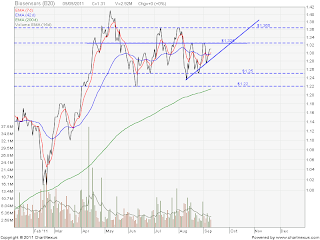SINGAPORE - Singapore-listed Olam International said on Monday the long-term outlook for most agricultural commodities was still bright despite the threat of a slowdown in demand triggered by economic woes, but weak fundamentals could work against cocoa.
Gold and copper suffered their biggest slump since the 2008 financial crisis as another brutal sell-off hit commodities on growing doubts Europe may be unable to prevent its debt crisis from dragging down the global economy But Sunny Verghese, Olam's chief executive officer, told Reuters growing demand for food, and shrinking supply, would support prices in the long run.
'Right now we are facing increasing economic pressures on all markets, and since all asset classes are now more correlated, it is impacting commodity prices as well,' Mr Verghese said in an interview.
'Cyclically we will see probably a correction but over the medium and long term we see commodity prices remaining firm as we see growing imbalances between supply and demand for food.'
Olam, a
major global trading house which is the world's largest shipper of robusta coffee, is 14 per cent owned by Singapore state investor Temasek.
The company trades about
20 different commodities ranging from Australian almonds and African cashews to cocoa. It also operates coffee plantations in Laos and a rice business in Thailand. According to its website, Olam has some 10,000 customers.
Mr Verghese said the
company was unlikely to raise any equities to support medium-term growth and to achieve a target US$1 billion profit by the financial year ending 2016.
'We have already considerably strengthened our capital base,
even if the global capital market completely shuts down for the next couple of years, it does not matter for us because we have raised enough capital both on the debt and equities side,' Mr Verghese said.
'We will raise additional debt capital 2-3 years down the road but right now we don't need any... (and) we are unlikely to raise equity to support this growth,' Mr Verghese said referring the firm's 2016 financial year target.
Olam was bullish on coffee, where high-quality arabica beans rallied to their highest in more than 30 years this year on supply concerns, but the outlook for cocoa was shaky because of a global supply surplus in the 2010/11 crop year.
New York cocoa futures rallied to their highest in 32 years around US$3,800 a tonne in March after fighting in top producer Ivory Coast ignited fears of supply disruptions. Prices have since dropped to around US$2,600.
'So we believe cocoa prices, for example, are still over valued despite the sell-off that happened in the recent past. So we are bearish on cocoa. We see a significant surplus globally, and therefore we expect cocoa prices to trend lower,' Mr Verghese said.
'We expect a surplus, our internal estimates are closer to 450,000 tonnes. I think the market is pricing in now about between 350,000 and 400,000, but we expect a bigger surplus - between 425,00 and 450,000.'
Current global coffee consumption is expected to grow as high as 2.7 per cent, and there will be a lag in supply growth because of minor increases in top robusta producer Vietnam, the world's largest producer of the variety used in instant coffee.
'In the last 10 years, demand has grown by an average of 2.25 per cent per annum. We expect going forward, demand will grow at more like 2.5 to 2.7 per cent per annum. It's already started,' said Mr Verghese, adding that demand for specialty coffee is on the rise.
Olam pegs Vietnam's coffee crop at 1.2 to 1.25 million tonnes in the 2011/12 crop year, slightly higher from 1.15 million tonnes in the crop year to September 2011 because there is few new plantings.
Indonesia, the world's second-largest robusta producer, will see a recovery in production in the main growing island of Sumatra, but domestic consumption is also expected to increase to up to 180,000 tonnes in 2011.
'We estimate Indonesia's local consumption now to have grown to about 170,000-180,000 tonnes. This is this year. It is growing at about 10 per cent per annum for the last, I would say, 5 years,' he added.
Sumatra's production is estimated at 250,000 tonnes in the 2011/12 crop year due to better weather, from 160,000 tonnes in the 2010/11.
On sugar, Olam expects raw sugar futures to find a floor at 24 US cents a pound equivalent to domestic ethanol prices in main sugar producer Brazil, after high prices curbed demand for the sweetener.
Mr Verghese said Olam, which has a market capitalisation of US$4.5 billion, is looking to develop or buy sugar plantation assets in Indonesia or Brazil.
However, he said the company is not currently looking at Indonesia's Papua region where Singapore's Wilmar, the world's largest listed palm oil firm, is trying to set up 200,000 hectares of sugar plantations.
New York sugar futures surged to their highest in more than three decades at around 36 US cents a pound in February after a massive cyclone struck Australia, one of the world's top exporters. Prices have slipped to around 24.80 cents.
'We're seeing for the first time a decline in consumption this year. It has never happened in history,' said Mr Verghese.
'We think 24 cents will provide a strong support. We also see sugar consumption growth being very strong, apart from this year's blip because of very high prices.' -- REUTERS






































